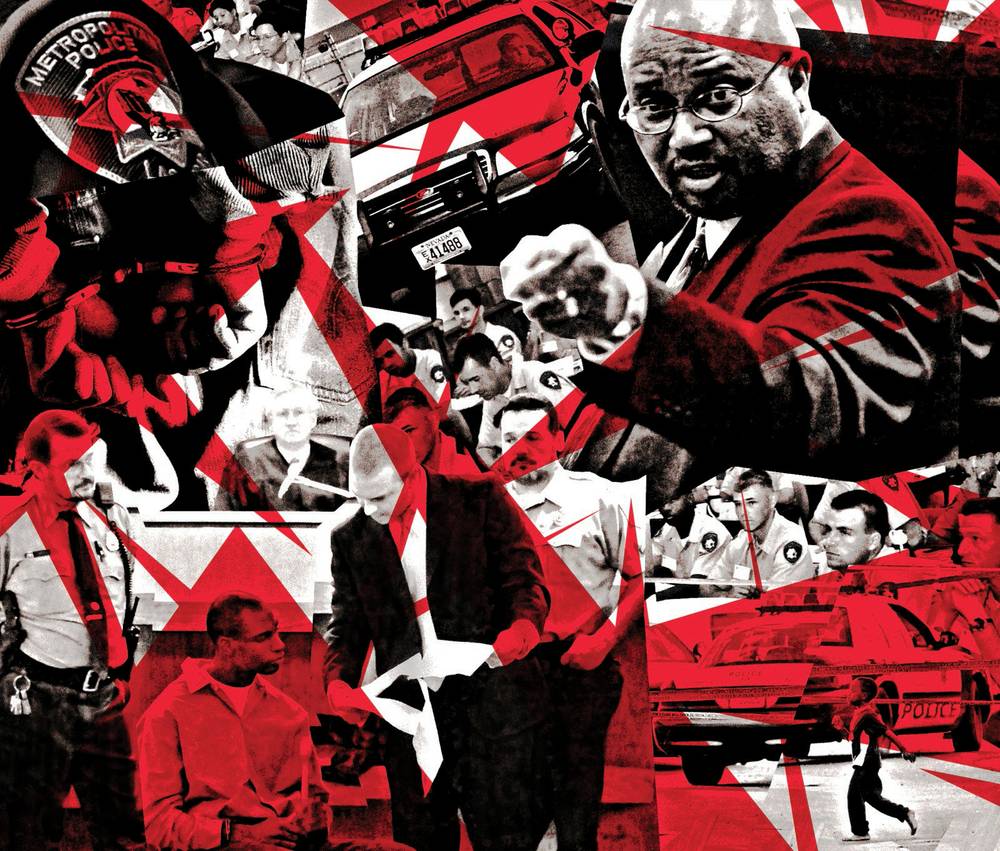We encourage our prosecutors to try cases,” says Clark County District Attorney David Roger. “We believe that in order to move 60,000 cases through the system, we need to develop top-notch litigators.”
Roger is responding to questions about a long-standing policy he instituted at the DA’s office that requires prosecutors to try five cases a year. Roger says that when he became DA in 2002, he found the office wasn’t trying a lot of cases. So he told his supervisors he wanted them to try three cases a year; for his prosecutors, it was five cases.
For him, the results were apparent. “We started getting better deals on cases,” he says, meaning defendants were making better deals (as far as prosecutors were concerned) for fear of having their cases actually tried.
Roger notes that crime is down 20 percent since 2003, which he attributes in part to the DA’s more aggressive posture on crime. The public, he says, “want us to aggressively prosecute criminals who make this a less safe place to live, and that’s what we’re doing.”
The problem, says his opposite number, Clark County Public Defender Phil Kohn, is that prosecutors may be trying cases for the wrong reasons. “Our understanding is people who do not do five trials are not eligible for raises,” says Kohn. “The DA’s obligation is to do justice. Our concern is if someone has to have five trials to be eligible for a raise or the number of trials affects their raise, how many trials are we going to do that the public is not being protected by?”
Kohn contends that it’s not uncommon for him to see cases that should not have gone to trial—although Roger counters that the public defender is just blowing smoke. “People like Phil Kohn have done everything to sidetrack our policy of trying cases.”
There has been an increase in the number of cases tried during Roger’s tenure versus that of his predecessor, Stewart Bell. In the last two years of Bell’s tenure, the DA’s office tried 133 and 117 cases. Now, Roger brings a little more than 200 cases to trial each year. Still, it’s a small number given the fact that his office files a staggering 60,000 cases a year. (Everyone agrees that a little more than 200 jury trials is about all the system can handle in a year.)
More
Not all prosecutors hit the five-trial mark. Some cases simply resolve before trial. But, says Roger, “If they’re just plea-bargaining every case without being aggressive, we’ll meet them and encourage them to be more aggressive.”
But Roger disputes as false the idea that the rule leads to weak cases being brought to trial. “There’s no constitutional right to a cushy plea deal,” he says. “Our prosecutors are pushing cases to trial. If the system works, and they are found guilty, then so be it … If the defense had an advantage you would not hear them complain.”
“It had been in place before me, and it’s in place after me,” says Stewart Bell of the rule. “I just didn’t adopt it. I think that you don’t want to set a situation where a lawyer is going to trial for the wrong reason.” On the other hand, he says he respects the logic of requiring prosecutors to develop their skills in the courtroom. “There’s no right or wrong. I really support David’s right to make any decision he wants.”
Bell says that when he served as a judge after being DA, he routinely dealt with prosecutors who did more than five cases. “Lawyers in front of me did a lot more than five, so there wasn’t much concern that they were trying cases for the wrong reasons.
“I want a DA to take a case to trial because there’s somebody who’s really hardheaded on our side or because they really think it’s a bad person, not because of a remuneration issue ... We only have enough judges to do about 220 jury trials a year … that’s about all you can do. So I think you have to make them count.”
Brian Nix has been running the state’s Victim of Crimes Program for 20 years, and it’s a labor of love. The state employee volunteers his time as coordinator. He designed the program’s website, and delights in taking me through it.
The program has been running since 1969; last year it helped between 2,500 and 3,000 people. The program allows innocent victims of crime to apply for restitution from the state to pay for medical bills, lost wages and, in some cases, mental-health counseling. The program is funded by fines assessed by the courts.
The problem is, in recent years the amount of money the program has brought in has exceeded the size of the program’s budget. The excess, by law, reverts to the state’s general fund. What that means is that in fiscal years ’06-’08, almost $1.5 million—about $900,000 from the state, and more than half a million in matching grants from the feds—that could have gone to the victims program did not.
While the program is able to pay off hugely expensive medical bills for a fraction of their costs (hospitals that accept payment from the program agree to consider it payment in full), state law caps restitution at $35,000 per victim.
A new bill, AB 114, which has already passed the state assembly and is now in the state senate, would close that loophole and allow the program to retain money in excess of its budget. “A lot of this is going to probably be moot for the next couple years. These revenues are probably not going to come into the courts at the same amount.” But he’s trying to look further down the road. Nix would like to see the program improved to help people with catastrophic injuries. But more importantly, getting money that should be going to help victims out of the general fund may give Nix’s program the cushion it needs. “What we’re going to do is build more of a safety net so that fluctuations in the economy don’t harm us.”
Lost amidst developing plans for a new, and expensive, city hall in downtown Las Vegas is the likely departure of another major tenant from the current city hall building: Metro. The department is hoping to consolidate into a new headquarters building itself. But it’s fair to ask whether any sort of move is wise in these tough economic times—the new city hall has faced tremendous criticism from the Culinary Union in part on those grounds.
Police spokesman Jay Rivera says the move makes sense. Cops will “no longer have to ask, ‘What’s your crime?’”—and then direct citizens to far-flung bureaus across the Valley. Now virtually the whole department will be conveniently housed under one roof.
Metro leases 148,000 square feet throughout the Valley, in addition to 78,000 square feet Downtown. Eliminating these leases would save $4 million a year. The proposed new space is bigger—370,500 square feet—and will cost the department $12 million a year. (By law, Metro is not allowed to own its own buildings.) Those costs will be split between the city of Las Vegas and Clark County. The new building would be at the corner of Alta and Martin Luther King Boulevard.








Previous Discussion: